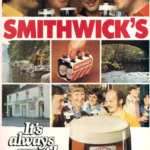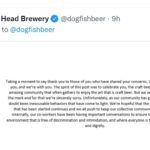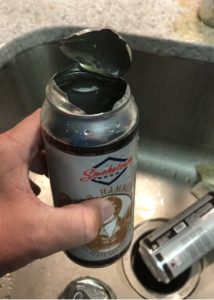Do you ever find yourself on a Wednesday evening and realizing you didn’t note a lot beery news in a week? No? Me neither. No way. What’s been going on? I can tell you for sure. Because I have been attentive. Saw stuff like this: Curtis walked into a 2005/2010 central New York beer store cosplay event this week. That was something. And I cracked a new databased to dig through for new 1700s New York brewery information as part of the work on Empire Beer. Just typing “Lispenard” gave me, like you, a rush as well as a renewed sense of purpose. I found a reference that pushed the brewing career of Mr. Leadbetter back one whole year. And Craig found Albany beer for sale in Boston in the 1730s. Inter-colonial beer shipments almost 300 years ago. Neato. Oh – and I didn’t drink beer in a graveyard. So there.
First up, I had no idea about France… keeping in mind the first thing that comes to mind with much beer industry writing is the question “is that really true?”:
It may be famous for its wine, but France is also the country with the largest number of breweries in Europe. This is how French beer changed its image from a “man’s drink” to a refined beverage worthy of an apéro… The number of microbreweries here has exploded over the past decade. The country went from having 442 active breweries in 2011, to 2,300 today, meaning no country in Europe has more breweries than France, according to the trade union Brasseurs de France.
Next, an update on the Umqombothi situation. You will recall that in June a man took the prize for making the best Umqombothi, right? Well, now the traditional South African beer faces regulation:
With the newly-amended Liquor Products Act that came into effect last Friday, there are now strict production requirements that traditional beer merchants will have to abide by in order to stay on the right side of the law. Thembisile Ndlovu has made a name for herself as the queen of brewing umqombothi the natural way it was done by grandmothers back in the villages. The 36-year-old from Zondi in Soweto, who is owner of All Rounder Theme events that organises themed parties and provides catering, said the new law regulating the making of umqombothi would not affect her business.
Odd seeing Pellicle win second place in a “best blog” award this week. From Beer 52 which fulls wells knows what Pellicle is. It’s not that it got an award or came second. It’s that it recognized that the drinks website was a blog. There is an interesting comment hidden in the explanation of the award:
…Pellicle has stuck to a founding principle that I recall finding quite radical at the time: kindness. Next to the toxic dumping ground of rivalry and acrimony that is Beer Twitter, Pellicle has been unremittingly positive in choosing what to cover and how to cover it.
I don’t disagree but I also find it weird that the fairly barren wasteland for any beer discussion on Twitter is set up as the comparator. Having made a hobby of reading this stuff every week, beer Twitter died off a long time ago. May still be general jerk Twitter, sure. And both GHB Sightlines and Dave Infante’s Fingers have recently seen the need to put up a paywall to make ends meet. Is “beer blog” the last phrase standing? Maybe so – if that is what Pellicle is. Speaking of which, they published an excellent piece by Will Hawkes on hops growing in England:
Crucially, the hop gardens sit on rich, fertile Brickearth soil, windblown loam and silt, deposited during the Ice Age. The Thames Estuary is just three miles away, and the hops, which grow on a gentle east-facing slope, are frequently buffeted by wind. This proximity to the sea is part of what makes East Kent Goldings what they are, although John regards it as a mixed blessing. “They can end up a bit bashed and brown,” he says. “The German hops are always pristine! They must get no wind there.”
Speaking of which, Stan’s Hop Queries blog by email showed up this week including observations on the Colorado hop market:
MillerCoors (now MolsonCoors) subsidized Colorado’s mini-hop boom in the teens, paying much more for Colorado grown hops than the brewery would have for the same varieties from the Northwest. They were, and are, used in the Colorado Native line of beers. That includes seven year-round brands and four seasonals that are brewed with 100% Colorado-grown ingredients. However, a few years ago MolsonCoors cut back its hop contracts to “right-size” inventory. Many farmers weren’t ready to compete.
Stan also noted that the Ales Through the Ages beer history conference has gone Zoomy and yet, even after scrapping the junket side, has also ditched all of the original speakers. Did ticket sales bomb for what many thought, as I observed last April, could have been called “Males on Ales Through the Ages”?
And Andy Crouch guided me to an article in Wine Enthusiast on the tepid performative solidarity craft beer is displaying in response to bigotries in the craft beer trade:
“… I keep getting messages and emails and calls, and people just stopping by the brewery, every day, just being like either this person apologized to me, or this person was fired, or the company just did this for everybody, and just letting me know all these really positive changes that people are actually sticking to and doing what they say. “It is heartwarming to know that it actually is helping people and creating lasting change.” To bring these issues to light in the customer sphere, in July, Allan announced a collaboration beer called Brave Noise. Its aim is to promote a safe and discrimination-free beer industry. At press time, fewer than 100 breweries had committed to the project.
Craft fibs category ticked. Back in England but still about forms of ticking, Mudgie guided me to the post at Real Ale, Real Music about an excellent pub crawl in Preston:
I retraced my route, passing dozens of takeways, a few restaurants, vape shops, beauty salons, and the odd pub as Saturday evening came to life. I had decided I would visit one more place before getting the train home. It was back across town, back to Fishergate, where down the side street by Barclays Bank was the Winckley Street Ale House, another recommendation from earlier in the day. There were tables outside, as there were at other spots on a pleasant side street, and as I walked in I joined a queue to the bar. It moved slowly, but finally it was my turn.
Reality. I believe what I read in that story more than I believe that France has more breweries than any other country in Europe. Or that much of craft cares. Facts! That’s what we need.
That’s it. For more check out the updates from Boak and Bailey mostly every Saturday and from Stan now apparently a regular again every Monday, plus more with the weekly Beer Ladies Podcast (this week… VIKINGS!!!), at the weekly OCBG Podcast on Tuesday and sometimes on a Friday posts at The Fizz as well. There is a monthly sort of round up at The Glass. There is more from the DaftAboutCraft podcast, too. And the Beervana podcast. And sign up for Katie’s weekly newsletter, The Gulp, too. And check out the Atlantic Canada Beer Blog‘s weekly roundup. Plus follow the venerable Full Pint podcast. And Fermentation Radio with Emma Inch. The AfroBeerChick podcast as well! And also look at Brewsround and Cabin Fever. And Ben has his own podcast, Beer and Badword – when he isn’t in hiatus as at the mo, more like timeout for rudeness! And remember BeerEdge, too, and The Moon Under Water.













